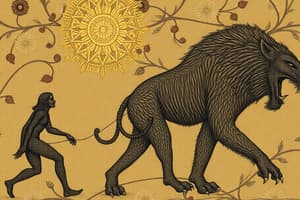Podcast
Questions and Answers
What is the main process responsible for the increase in frequency of advantageous traits within a population over time?
What is the main process responsible for the increase in frequency of advantageous traits within a population over time?
- Mutation
- Genetic variation
- Natural selection (correct)
- Adaptation
Which term describes the process where species evolve traits to better fit their environment?
Which term describes the process where species evolve traits to better fit their environment?
- Gene flow
- Genetic drift
- Mutation
- Adaptation (correct)
What is the driving force behind the emergence of new species?
What is the driving force behind the emergence of new species?
- Gene flow
- Genetic drift
- Natural selection (correct)
- Mutation
Which term best describes the process of creating genetic variation through changes in DNA sequences?
Which term best describes the process of creating genetic variation through changes in DNA sequences?
In the example of the peppered moth, what caused the increase in frequency of dark-colored moths during the Industrial Revolution?
In the example of the peppered moth, what caused the increase in frequency of dark-colored moths during the Industrial Revolution?
What is the molecule that carries genetic information from one generation to the next?
What is the molecule that carries genetic information from one generation to the next?
Which of the following pairs correctly represents complementary base pairs in DNA?
Which of the following pairs correctly represents complementary base pairs in DNA?
What initiates diversity in life by creating new genetic variations within populations?
What initiates diversity in life by creating new genetic variations within populations?
What is the raw material that species diversity is formed from?
What is the raw material that species diversity is formed from?
What process refers to the gradual process by which biological traits become either more or less common in a population?
What process refers to the gradual process by which biological traits become either more or less common in a population?
Flashcards are hidden until you start studying
Study Notes
Inheritance, Variation, and Evolution: Unraveling Life's Dynamic Process
Life is a diverse and ever-changing tapestry, woven through the interplay of inheritance, variation, and evolution. As we delve into each of these fundamental concepts, we'll discover how genetics, mutation, species diversity, and natural selection combine to shape the world around us.
Genetics
The thread of life's tapestry is DNA, or deoxyribonucleic acid, a molecule that carries genetic information from one generation to the next. DNA is composed of a double helix structure, with long strands of nucleotides that form complementary base pairs, such as adenine (A) with thymine (T) and cytosine (C) with guanine (G). Each DNA strand is accompanied by a protein called histone, which helps package the DNA into a compact structure called chromatin.
Mutation
Diversity in life begins with tiny changes in DNA called mutations. Mutations happen naturally, for example due to errors during cell division or as a response to environmental factors (such as radiation). These changes can be passed down to offspring, creating new genetic variations within populations.
Species Diversity
Variation, fueled by mutation, is the raw material that species diversity is formed from. Species diversity refers to the variety of life forms found within a specific ecosystem. Diversity can be observed at different levels, from genes and genes within a genome to species, communities, and ecosystems.
Natural Selection
Natural selection is the process by which genetic variations that are advantageous for an organism's survival and reproduction are more likely to be passed on to future generations. As a result, the frequency of these advantageous traits increases over time within a population.
Adaptation
Adaptation is a consequence of natural selection, and it occurs when species evolve traits that enable them to better fit their environment. Adaptations can be physical, such as the elongated beaks of Darwin's finches that enable them to better extract food from different food sources, or behavioral, such as the migratory patterns of birds that help them find optimal breeding and feeding grounds.
An Example: The Peppered Moth
The peppered moth (Biston betularia) provides a classic example of how natural selection can lead to rapid changes in a population. Peppered moths are found in both light-colored and dark-colored forms. In the 19th century, when pollution was less common, light-colored moths were more common than dark-colored ones due to their camouflage against the light-colored bark of trees. However, during the Industrial Revolution, air pollution caused tree bark to darken, making the dark-colored moths better camouflaged. As a result, the frequency of dark-colored moths increased over time.
In summary, the interplay between inheritance, variation, and evolution is a driving force of life's diversity. Through mutation, genetic variation is created, and natural selection leads to adaptation and the emergence of new species. The peppered moth is a prime example of how natural selection can cause rapid changes in populations, underscoring the ongoing process that shapes the world we live in.
Studying That Suits You
Use AI to generate personalized quizzes and flashcards to suit your learning preferences.




